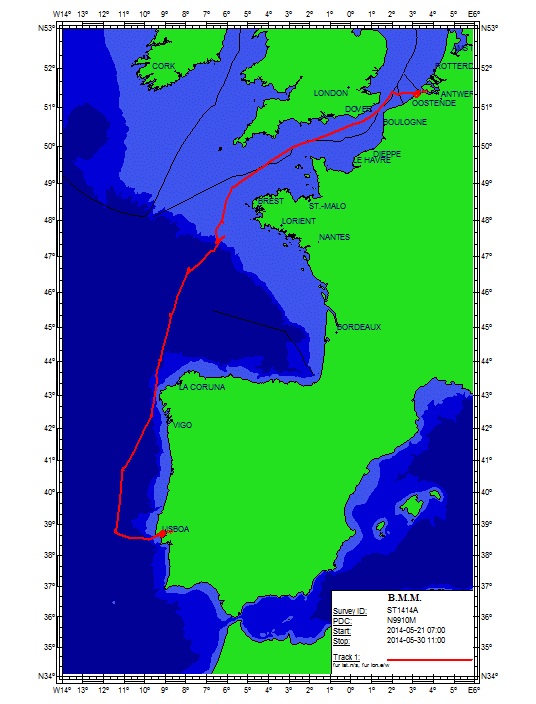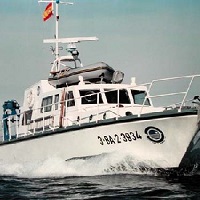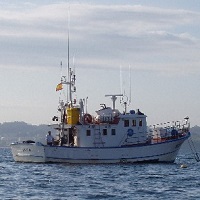Creation year
2014
240 record(s)
Type of resources
Categories
Topics
INSPIRE themes
Keywords
Contact for the resource
Provided by
Years
Formats
Status
-
The objective of cruise JC103 was to service the moorings of the RAPID 26°N project that are deployed to monitor the Atlantic Meridional Overturning Circulation. For each mooring instruments were recovered, data were downloaded and instruments were redeployed. A number of CTDs were made to calibrate the instruments from the moorings. During passage from port of Spain to Nassau trial CTDs were completed in the waters of the Turks and Caicos Islands. After departing Nassau on 29th April work commenced on the western boundary sub-array comprising of moorings WBADCP, WBAL, WB1, WB2, WB2l, WB2h, WB4 and WB4L. The ship returned to Nassau on 6th May to disembark one person before sailing east once again. The final mooring of the wester sub-array was serviced on 8th May before continuing east to the mid-Atlantic Ridge (MAR) sub-array. Work on the MAR sub-array commenced on 13th May at mooring MAR0. The other moorings in this sub-array were MAR1, MAR1L, MAR2, MAR3 and MAR3L were all completed by 18th May. On the following day the NOG mooring was deployed and as the ship transited to the astern sub-array the first of 5 Argo floats was deployed on 21st May. The eastern boundary sub-array starts at EB1, which was serviced on 23rd May. Following this moorings at EB1L, EBHi, EBH1, EBH2, EBh3,EBh4 and EBH4L in the following days up until 31st May. A number of CTDs were completed form 31st may to 2nd June.
-
The main objective of the MOOSE-GE cruises is to observe the annual evolution of the Northwestern Mediterranean Sea in the context of the climate change and anthropogenic pressure in order to be able to detect and identify long-term environmental trend and anomalies of the marine ecosystem. The annual cruise focuses on moorings maintenance and hydrology, biogeochemistry and biology monitoring of the Northwestern Mediterranean basin. It aims to follow variability of water masses properties (LIW and WMDW) and biogeochemical and biological content related to these water masses. BILLION 36 cruise was part of this cruise too.
-
<p>The MEDITGIB 2014 campaign is a physical oceanography campaign; it aims to study the Mediterranean outflow and its future in the Gulf of Cadiz. The aim is to qualify the Mediterranean waters at the entrance to the Strait upstream and monitor their transformation through the Strait to identify mixing zones along the way. The monitoring extends downstream into the Gulf of Cadiz where the Mediterranean outflow enters at the exit of the Strait: its extension and distribution in the Gulf are part of the problem of the campaign. In the direction entering the Mediterranean Sea, the aim is to follow the Atlantic surface waters and their future towards the Mediterranean Sea;</p> <p>One of the rapid dynamic oceanographic processes that potentially has a role in the Strait area as well as to the east is the internal waves; MeditGib is particularly interested in the generation zones identified in the Camarinal threshold area and the eastward propagation of the generated waves. To this end, several instrumental devices are moored (current meter, thermistor chain) throughout the campaign.</p>
-

The research programme of Belgica campaign 2014/14 aimed at assessing the different biogeochemical processes controlling the carbon and nitrogen cycles in oligotrophic N.E. Atlantic waters. These cycles are essential components of the biological Carbon Pump' by which part of atmospheric carbon dioxide is transferred to the ocean's interior. Our approach is based on the use of dual nitrate isotope measurements (natural abundance and enrichment experiments) to disentangle these various nitrogen processes in the marine environment, and in particular the process of diazotrophy by which atmospheric N2 is introduced into the oceanic fixed nitrogen reservoir. This input of new' nitrogen should stand in balance with the denitrification process by which nitrogen is lost from the oceanic system. There are indications that the intensity as well as the geographical distribution of diazotrophic activity has been underestimated till date, in general. It is of particular interest to better document diazotrophic activity at latitudes of 38°N and northward, areas for which only few data are available. During the cruise we studied the different biogeochemical processes acting on the marine N-cycle, including N2 fixation, nitrate (NO3-), ammonium (NH4+) and nitrite (NO2-) uptake, nitrification, along a north-south section through the Gulf of Biscaye to Cape Finisterre and further south in open ocean waters along the Iberian peninsula till about 38°30'N. In addition, the effect of iron limitation on the nitrogen fixation and the nitrification processes was investigated.
-
Assessment of small pelagic species resources in the Gulf of Lion. This falls under the MEDIAS project.
-

Weekly cruise to monitorize physical and chemical variables in Rias Baixas (Galicia)
-

Weekly cruise to monitorize physical and chemical variables in Rías Altas (Galicia)
-

Weekly cruise to monitorize physical and chemical variables in Rias Baixas (Galicia)
-

Weekly cruise to monitorize physical and chemical variables in Rias Baixas (Galicia)
-

Weekly cruise to monitorize physical and chemical variables in Rias Baixas (Galicia)
 Catálogo de datos del IEO
Catálogo de datos del IEO